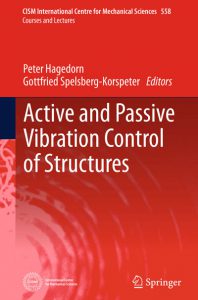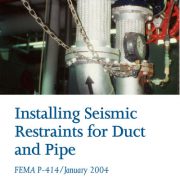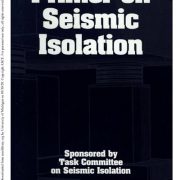Active and Passive Vibration Control of Structures
CISM International Centre for Mechanical Sciences 558Courses and Lectures
This work is subject to copyright. All rights are reserved by the Publisher, whether the whole or part of the material is concerned, speciÀ cally the rights of translation, reprinting, reuse of illustrations, recitation, broadcasting, reproduction on microÀ lms or in any other physical way, and transmission or information storage and retrieval, electronic adaptation, computer software, or by similar or dissimilar methodology now known or hereafter developed. Ex-empted from this legal reservation are brief excerpts in connection with reviews or scholarly analysis or material supplied speciÀ cally for the purpose of being entered and executed on a computer system, for exclusive use by the purchaser of the work. Duplication of this pub-lication or parts thereof is permitted only under the provisions of the Copyright Law of the Publisher’s location, in its current version, and permission for use must always be obtained from Springer. Permissions for use may be obtained through RightsLink at the Copyright Clearance Center.
Violations are liable to prosecution under the respective Copyright Law
The use of general descriptive names, registered names, trademarks, service marks, etc. in this publication does not imply, even in the absence of a speciÀ c statement, that such names are exempt from the relevant protective laws and regulations and therefore free for general use. While the advice and information in this book are believed to be true and accurate at the date of publication, neither the authors nor the editors nor the publisher can ac-cept any legal responsibility for any errors or omissions that may be made. The publish-er makes no warranty, express or implied, with respect to the material contained herein.All contributions have been typeset by the authorsPrinted in ItalyPrinted on acid-free paperSpringer is part of Springer Science+Business Media (www.springer.com)
PREFACEActive and passive vibration control of structures
form a topic ofvery actual interest in many different fields of engineering, for ex-ample in the automotive industry, in aerospace engineering (e.g. inlarge telescopes) and also in civil engineering. The material presentedin this book tries to fill gaps between structural mechanics, vibrationsand modern control theory. It also establishes links between the dif-ferent applications in structural control. In vibration control it is stillcommon practice to a large extent to regard the design of mechanicalstructures and their damping and control as different topics, whichoften are treated sequentially, with the design of the structure to becarried out first, followed later by designing the active and passivevibration control. Similarly, in the standard curricula at most uni-versities, the mechanical modelling and the design of structures aswell as their control are treated as separate subjects. This book in-tends to fill some of the gaps between these different issues.
Theintention is to give a solid foundation of the mechanical
modellingand the vibration control for discrete and continuous structures, withan emphasis on the interfaces of the different disciplines.This book was written accompanying the CISM Course no. 418entitled ‘Active and Passive Vibration Control of Structures’ held inUdine from May 27 to 31, 2013. Therefore it is directed to youngresearchers, to doctoral students and also to engineers working infields related to structures, vibrations and control.
A thorough introduction into the relevant theory
both of the me-chanical modelling as well as of the vibration control theory are pre-sented and the most important design goals are discussed. Variousstrategies for modelling complex mechanical structures are given andan introduction to active, passive and semi-active strategies for vi-bration control are discussed. In a number of examples from differentareas it is shown that a comprehensive approach, in which both themechanical design problem and the development of suitable controlsare considered simultaneously, can present substantial advantages.The organization of the book is as follows.Chapter I, byPeter Hagedorn(Technische Universit ̈at Darm-stadt, Germany), treats equations of motion for discrete and con-
tinuous mechanical systems laying
the foundation for the creation ofcontrol models.Chapter II, byGottfried Spelsberg-Korspeter(TechnischeUniversit ̈at Darmstadt, Germany), gives an introduction to varia-tional principles in mechanics and control relating to mechanical mod-elling and the development of control strategies.Chapter III, byAndre Preumont,David AlalufandRenaudBastaits(Universit ́e Libre de Bruxelles, Belgium), treat hybrid massdampers for mitigating the dynamic response of buildings.Chapter IV, byAndre PreumontandBilal Mokrani(Uni-versit ́e Libre de Bruxelles, Belgium), discuss the theory of electromag-netic and piezoelectric transducers and presents some applications instructural control.Chapter V, byRobert Skelton(University of California SanDiego, United States), focuses on structure and design of control sys-tems with an emphasis on the advantages of using matrix inequalities.
Chapter VI, byAdnan Akay(Bilkent University, Turkey)
andAntonio Carcaterra(University of Rome, Italy), address thephysics and modelling of structural damping which is extremely im-portant in almost every structural control problem.Chapter VII, byRainer Nordmann(Technische Universit ̈atDarmstadt, Germany), deals with active magnetic bearings, whichcan be used for control purposes in rotating machinery.Summarizing, the material presented in this book will offer a uni-fied view on active and passive control and the mechanical modellingof structures presented from the point of view of experienced research-ers with quite different perspectives.The authors want to express their gratitude for the support of theCISM organization, in particular to Professor Friedrich Pfeiffer forchairing the course in Udine, and to Carla Toros for her tremendoussupport in organizing it.The authors sincerely thank Manuel Eckstein, who carried themain burden of editing the manuscripts and coordinating the differ-ent chapters, as well to Eduard Heffel, Matthias Heymanns, HenningSpiegelberg and Andreas Wagner.
Detials:
| عنوان | The Building Environment:Active and Passive Control Systems – THIRD EDITION
|
| نویسنده | Peter Hagedorn Gottfried Spelsberg-Korspeter |
| زبان | English |
| Size | 13.5 MB |
| Download Method | مستقیم |
| Download Links | Download The Building Environment:Active and Passive Control Systems – THIRD EDITION |






 تهران، شهرک غرب، بلوار خوردین، بلوار شریفی، توحید 4، پلاک 6، واحد 111
تهران، شهرک غرب، بلوار خوردین، بلوار شریفی، توحید 4، پلاک 6، واحد 111

